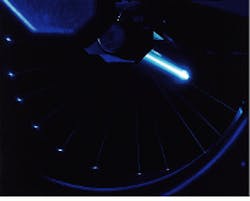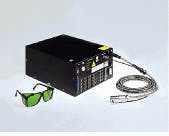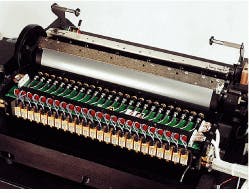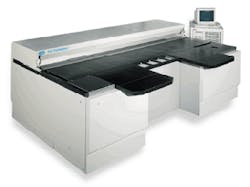Diode lasers fuel platemaking advances
RON GIBBS
The use of diode lasers in commercial printing applications has increased greatly during the last few years. In imagesetters, which are high-quality laser image recorders used to produce color-separation films, air-cooled argon-ion lasers emitting at 488 nm—the industry standard laser for many years—have been largely superseded by low-power single-mode diode lasers emitting at 780 and 670 nm. The low cost, direct-modulation capability, and long lifetime of semiconductor lasers have encouraged development of high-contrast films optimized for these wavelengths. In the meantime, major changes have also been taking place in the structure of the prepress industry, driven by technology change and by increasing demand for short-run color printing. These changes have resulted in the emergence of desktop-publishing software that allows high-quality page designs to be originated without any of the highly skilled technicians that were needed previously. Another result has been a huge growth in interest in computer-to-plate (CTP) technology.
Computer-to-plate technology eliminates a complete stage in the production of printing plates. Instead of film-based color separations being used to image the plate by contact exposure with an ultraviolet (UV) source, the plate surface is imaged directly by exposing it with a laser beam.
Thermal CTP
The earliest CTP systems used high-power UV-emitting argon-ion lasers to expose existing UV-sensitive printing plates. Later-generation systems, developed in the early 1990s, used low- or medium-power lasers to expose a wide range of photosensitive coated plates that required subsequent chemical processing to develop the images. The most successful of these systems used medium-power lasers—initially 488-nm argon-ion lasers, then frequency-doubled diode-pumped solid-state lasers (DPSSLs) emitting at 532 nm—to expose photopolymer plates.
At the printing industry`s top trade show in 1995 (DRUPA; Dusseldorf, Germany), a confusing variety of competing systems were launched, demonstrated, or announced, which used many different plate and film materials and different lasers (see Laser Focus World, Nov. 1995, p. 77). To most industry observers, it was unclear whether CTP was really a viable technology and which systems would prove to be technically and commercially successful.
Two years later, although CTP sales are still low, interest has shifted sharply to thermal plates—which require no chemical processing—and CTP finally looks set to take off and replace film-based processes. These plates have a very sharp exposure threshold, determined by a temperature-dependent surface transition and, therefore, give very "hard" halftone dots, which print consistently well. Commercial printing firms, which are the main customers for these systems, are attracted to the operational simplicity, speed, and quality of platemaking using this method.
Two main types of offset-lithographic-printing plate have been developed for this market. One class of plate, as developed by Presstek (Hudson, NH), Polaroid Graphic Imaging (Waltham, MA), and E. I. DuPont de Nemours and Company (Wilmington, DE) is based on laser ablation of thin layers and can give exposure thresholds of less than 100 mJ/cm2. These materials are best suited to very short exposures, as the heat generated at the surface layer has less time to be conducted away by the aluminum substrate.
The other materials technology available is thermal cross-linking of polymers, as developed by Kodak (Rochester, NY) and Horsell-Anitec (Leeds, England). These plates have a threshold exposure of 200 mJ/cm2, require wet processing to remove material from nonimage areas, and are less suitable for very short pulse exposures, requiring a longer reaction time. They do, however, give better printing characteristics than the ablated plates.
Most plate manufacturers produce different materials optimized for absorption of either 830-nm laser diodes or 1064-nm DPSSLs. The 830-nm wavelength is a compromise between shorter wavelengths, which allow more efficient absorption at the plate, and longer wavelengths, which allow more powerful diode lasers to be used. The laser power requirements for these systems (Plaser) are determined by the material exposure threshold and the required imaging speed, together with the scanning geometry adopted, aswhere Eth = plate exposure threshold; A = plate area; h = optical efficiency, including scan duty cycle; and Tp = time to expose a plate.
For an image size of 0.5 m2 and exposure threshold of 200 mJ/cm2, a laser power of 35 W is required to expose a plate in two minutes in a 60%-efficient optical-scanning system. Image-resolution requirements are very demanding because of the halftone dot structure needed to achieve tone gradations in offset-lithography printing. Requirements range from 800 dots per inch (dpi) for newspapers to 4000 dpi for high-quality art reproduction, implying a laser spot size of 10 to 54 µm. The ideal platesetter would be capable of exposing a wide range of resolutions and plate sizes, but practical considerations make this impossible so the platesetter market is highly segmented.
Single-beam exposure
Single-beam laser-scanning systems make use of either flat-field or internal-drum scan geometry. For most applications, the combination of requirements for resolution and plate size make f/q lens designs impractical. In the internal-drum configuration, the plate is held stationary in the shape of a cylinder, while a spinning mirror on the cylinder axis projects a focused spot onto the internal surface of the plate and is translated along the drum axis on a linear slide. Internal-drum platesetters have simple on-axis optics, but mechanical tolerances are demanding because of the long optical levers inherent in the design. The spot size, and therefore image resolution, can be changed relatively easily by changing the expansion ratio of the afocal beam-expander telescope that typically precedes the focusing lens in the optical train.
Because it is relatively easy to design a new laser into an internal-drum system, the drum arrangement has been popular recently. Companies such as Gerber (South Windsor, CT), Purup-Eskophot (Lystrup, Denmark), and Cymbolic Sciences (Aliso Viejo, CA) have developed internal-drum imagesetter technology over many years and were well placed to apply this configuration to thermal CTP, while many other companies have also adopted this design (see Fig. 1).
Single-spatial-mode operation and excellent beam-pointing stability from the laser are essential for good imaging performance in this scanning configuration. The rotation rate of the spinning mirror, which scans the beam around the internal-drum surface, limits the scanning speed. Recent advances in hydrodynamic air bearings and mirror design by suppliers such as Westwind Bearings (Poole, England) and Speedring (Rochester Hills, MI) have resulted in mirrors that can rotate at speeds up to 40,000 rpm.
A further problem with single-beam systems is the modulation required to produce the image. Acousto-optic Bragg cells require the beam to be focused to achieve high modulation bandwidth—resulting in extremely high optical-power density inside the modulator crystal. This typically limits the power throughput to less than 20 W before catastrophic laser-induced damage to the crystal results.
In the very earliest thermal CTP system, originally developed by LogeScan (Springfield, VA) in the early 1980s, a lamp-pumped 1.06-µm Nd:YAG laser was used in an internal-drum configuration. At the time the product was discontinued in 1990—then under the name Datrax, owned by Crosfield Electronics—a 20-W laser was being used. Single-mode outputs of 30 W have been achieved from commercial lamp-pumped Nd:YAG lasers, but the power supply and water-cooling requirements for this laser make it impractical for most end users.
Recent advances in DPSSL development have produced more efficient and practical single-mode laser sources. The high cost of pump lasers has limited commercially available DPSSL output power to 10 W, although output powers are expected to increase significantly as the cost of pump lasers falls over the next two years. The higher efficiency of these lasers, together with the use of fiber coupling, has reduced the importance of thermal effects and allowed the use of more-efficient host crystals than YAG, including YLF and YVO4. Not only are these lasers more efficient, they also exhibit excellent pointing stability and are very compact, which means they can be mounted on moving carriages within platesetters.
Very recent progress in diode-pumped rare-earth-doped fiber lasers (see Laser Focus World, May 1997, p. 143) has opened up exciting new possibilities for low-cost, high-power single-mode sources. A 9-W fiber laser is commercially available from SDL (San Jose, CA), and the company has also demonstrated a 16-W laser in the laboratory. In May at CLEO '97 (Baltimore, MD), Polaroid (Cambridge, MA) presented results from a laboratory laser that produced 35 W of single-mode output, the highest continuous-wave (CW) output reported to date (see Laser Focus World, July 1997, p. 16, and Fig. 2). Of particular interest is an innovative Russian design from IRE-Polus (Burbach, Germany) that allows direct current modulation of a 10-W quasi-CW beam at rates up to 100 MHz.Multiple-beam exposure
The problems of modulation and exacting laser specifications associated with single-beam systems can be avoided by the use of multiple laser beams. The low cost per watt of diode lasers makes this class of design possible at an economic manufacturing cost. In addition to making it easier to obtain the total laser power required, the mechanical and modulation speeds required scale down in proportion to the number of beams used.
Most multiple-beam systems use an external drum configuration in which the printing plate is attached to a large cylindrical drum that rotates while the optical system is translated on a linear slide. The complexity of the optical system means these systems have fixed spot size and resolution. The short optical paths that are possible in this configuration allow the use of multimode lasers and improve mechanical stability by reducing the optical lever effect. Image-quality problems, such as banding—including moiré patterns from beating between printing dot screen structures—result from differences in spot intensity and shape, uneven beam spacing, and nonstraightness of arrays ("smile"). These problems must, therefore, be avoided or corrected for in multiple-beam systems.
One approach to designing a multiple-beam system is to use many individual diode lasers. A Presstek system is based on arrays of up to 32 fiber-coupled 550-mW lasers equispaced along the length of the cylinder (see Fig. 3). CREO (Burnaby, BC, Canada) previously used array assemblies of up to 64 lasers, arranged at an angle to the scan direction such that adjacent beams overlap.Kodak has extended this concept by superimposing several single-mode diode-laser outputs with a diffractive optical element to form each channel.1 This design results in built-in redundancy—allowing automatic compensation for failure of any one diode in the field—and greatly increases the reliability of the system. A 10-channel printhead with 16 lasers per channel is in production and is being used in several manufacturers' platesetter systems. A 16-channel printhead with 12 lasers per channel is currently under development. If 200-mW diode lasers were used, this would give a maximum total power capability of 38 W.
The alternative approach to multiple-beam exposure is to uniformly illuminate a linear spatial light modulator (SLM). The illumination can be provided by a multimode laser bar consisting of a monolithic linear array. These devices have been developed over many years as high-power sources for pumping DPSSLs and as sources of high power for applications requiring a relatively large spot, such as laser machining and surgery. Bars with outputs up to 20 W are currently commercially available from suppliers including SDL, Opto Power (Tucson, AZ), and Coherent (Santa Clara, CA), and 40-W bars will be available in the near future.
CREO has captured market leadership in thermal platesetters with an SLM system of this type that has 230 channels (see Fig. 4). ICG (Cheltenham, England) is developing a rival system using an alternative light-modulation device with more than 500 channels. Both companies decline to reveal details of their optical systems, but several light-valve-array technologies exist that could be suitable, including acousto-optic traveling-wave Bragg cells and the ferroelectric SLM developed by CRL (Hayes, England).The ICG system scans the plate in a flatbed configuration, with x-y linear translation of the optical head, rather than an external-drum configuration. This enables efficient exposure of plates of different sizes and enables relatively simple, efficient automatic plate-handling systems to be used.
Looking forward
Although the market for CTP systems is still relatively small, and the thermal CTP niche is still smaller, the combination of new plate materials and creative laser and platesetter design has created great excitement within the printing industry. New product developments since DRUPA 95—many of which were launched at Imprinta in June 1997 (Dusseldorf, Germany)—suggest the printing industry is finally starting to accept the technology. So a rapid change from film to CTP will likely take place over the next five years.
While several laser types are competing for this market, there is sufficient potential for improvement in the performance of the laser systems to give confidence that manufacturers will overcome the inherent speed disadvantage of the plate materials over photosensitive materials.
REFERENCE
1. S. K. Wyatt, SPIE Vol. 3000, p.169 (Feb. 1997).




